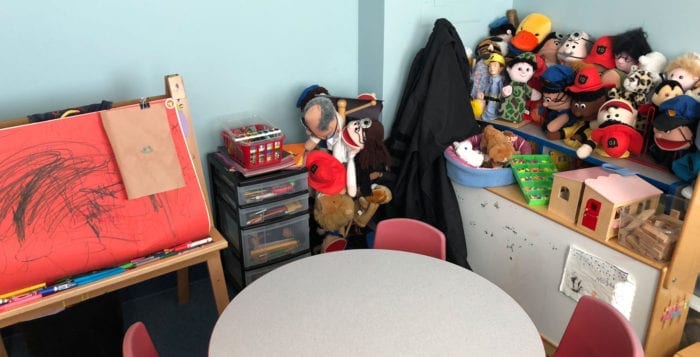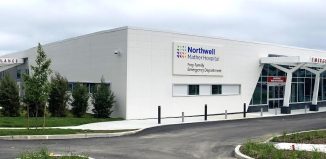#MeToo movement is wind in sails for Suffolk’s Crime Victims Center

In a time of changing cultural and societal norms related to the treatment of victims of sexual abuse, Laura Ahearn now has a movement behind her decades-long mission.
The founder of Parents for Megan’s Law and the Crime Victims Center, a not-for-profit organization, has been a relentless advocate for victims since the late ‘90s. What started as a small operation running out of her Three Village home advocating for sex offender registration has grown into a three-pronged program that is used as a model by other advocacy groups. The CVC assists victims of child sex abuse and rape, provides services to victims of violent crime, and assists elderly, disabled and minor victims of all crime. Its mission is now virtually a daily part of the national conversation.
“The #MeToo movement has created an ideal climate for us to call upon legislators to help us change a culture which has minimized sexual harassment.”
— Laura Ahearn
“It’s a tremendous opportunity for organizations like ours that have worked with child sexual abuse and adult victims of sex crimes to be able to open up a dialogue now with a higher volume of a voice with state, local and federal legislators,” Ahearn said after attending a breakfast at Stony Brook University that featured lawmakers from across Long Island and all levels of government. The meeting was part of a daylong event designed to start a conversation about localizing the national #MeToo movement, a social media campaign started by Tarana Burke, a survivor of sexual violence. Burke also attended the SBU event.
“The #MeToo movement has created an ideal climate for us to call upon legislators to help us change a culture which has minimized sexual harassment, and a society or environment whose prevailing social attitudes have the effect of normalizing or trivializing sexual assault and sexual harassment,” Ahearn said.
The group has a list of legislative goals it would like to advance in 2018, like criminalizing “revenge porn” and advancing the Child Victims Act, a state law that has passed the Assembly but not the Senate, which would extend the time frame for a victim to bring forward allegations against an abuser.
Victim advocacy
Though its actual functions have evolved over the years, advocating for victims remains Ahearn’s and the CVC’s primary objective.
The center, with locations in Ronkonkoma and Patchogue, is a certified rape crisis center.
The group has long provided advocacy for child victims of sexual abuse, and has since added advocacy components for adult rape and adult domestic violence victims. In 2006, the mission shifted to provide support for victims of all violent or hate crimes.
“These are cases that are failing between the cracks and no one was helping them,” said Ahearn said, a New York State licensed attorney and social worker.
“You feel like ‘This is why I’m doing this.’”
— Sally McDonald
Since 2015, the organization has been fed cases from the Suffolk County Police Department and District Attorney’s office through a cloud-based computer software program, allowing the CVC to directly contact innocent victims to begin providing support under the direction of Mike Gunther, CVC’s director of advocacy and victim services. The cloud program has served to streamline a process it had been carrying out since 1999. Ahearn said the CVC has helped to recoup $5.5 million for Suffolk County crime victims from a county fund to cover unexpected costs for innocent victims, as some have health insurance costs or other expenses to cover in the aftermath of a traumatic incident. Currently, the CVC has between 2,500 and 3,000 cases it’s handling, and its founder said the organization is always in need of more case managers.
The group regularly sends advocates Diana Shuffler and Diana Guzman to Human Trafficking Intervention Court, a New York state initiative established to aid victims of human trafficking in every aspect of getting their life back on track, and put legal issues behind them. Prior to the program’s inception, Guzman said victims of human trafficking picked up for other crimes like prostitution were treated like criminals. The CVC even works with the FBI.
Sally McDonald, a certified therapist and victim advocate at the CVC who is passionate about the work she does, said she has cases with victims ranging from 4 years old to adults in their 60s.
“It’s exciting — it’s so nice to see anybody do well, but especially a child,” she said of seeing someone’s life improve as a result of her work. “You feel like ‘This is why I’m doing this.’”
Ahearn stressed the importance of following up with victims and ensuring his or her traumatic incident is truly behind them.
“Whenever you’re dealing with any kind of violent crime or trauma, unless there are support services, those are individuals that are going to need help,” she said. “If they’re not getting the help they need … those kids whose families were victims of violent crime are going to gravitate toward who they believe is going to protect them, and in those communities that would be the ones that, believe it or not, are the perpetrators.”
“Whenever you’re dealing with any kind of violent crime or trauma, unless there are support services, those are individuals that are going to need help.”
— Laura Ahearn
The Ronkonkoma office features therapy rooms for all ages, including a child therapy room where kids are prepared for what to expect in a court setting, or play out personal trauma using a sandbox, toys or art therapy.
Sex offender monitoring
Megan’s Law gets its name from an incident in the mid-‘90s in which 7-year-old Megan Kanka from New Jersey was lured into a neighbor’s home, sexually assaulted and murdered. The culprit was a twice-convicted sex offender, and after a nationwide lobbying effort, Megan’s Law was passed in 1996 and required all 50 states to release information to the public about known convicted sex offenders.
Ahearn was one of those involved in the lobbying effort, and Parents for Megan’s Law was born. In 2014 the CVC implemented a new monitoring program to keep addresses and other important information about the county’s roughly 1,000 registered sex offenders current. Ahearn’s sex offender monitoring staff is comprised entirely of retired law enforcement officers, who regularly check up on the people on the list face-to-face to ensure their information is accurate and up to date.
The organization also has a Megan’s Law helpline as well as a tip line, should community members want to report anything related to a registered sex offender in their area.
Prevention
When describing the CVC’s prevention arm, Ahearn uses an analogy. Imagine you’re fishing, she says, and three separate times during the day you have to dive in the river to save people who were drowning as they headed downstream. How many times would you have to dive in the water to save a life before heading upstream to see why so many people are falling in the water and nearly drowning?
Led by prevention program manager Kim Malone, the CVC provides workshops for children, teens, parents and adults designed to empower them with knowledge and skills aimed at protecting against sexual abuse and abduction.
The CVC offers workshops for schools and organizations geared toward every age group.
To contact the Crime Victims Center call 631-689-2672 or visit www.parentsformeganslaw.org.
This story was updated Jan. 31 to correct the spelling of Laura Ahearn’s name.






